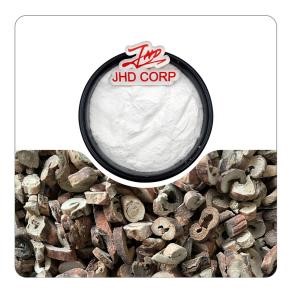Welcome to JHD Nutrasource!
Shop
Peony bark extract
Peony bark extract is derived from the root bark of the peony plant, most commonly Paeonia suffruticosa and Paeonia lactiflora. It is usually obtained through processes such as solvent extraction. The extract contains a variety of active ingredients, mainly including paeoniflorin, benzoylpaeoniflorin, paeonol, and other phenolic compounds. It typically appears as a brown – yellow powder or liquid, with a characteristic odor and taste of the peony plant.
Description
| Product Name | Peony Bark Extract |
| Appearance | light brown to tan powder |
| Specification | ≥5% or ≥10% |
| Test Method | HPLC |
| Source | the bark of the Paeonia suffruticosa plant |
| Certificate | Organic/Kosher/Halal/GMP/Non-GMO |
Function
- Anti – inflammatory: It has significant anti – inflammatory effects. The active ingredients in peony bark extract can inhibit the production and release of inflammatory mediators, such as cytokines and prostaglandins, thereby reducing inflammation in the body. This helps in alleviating inflammatory – related diseases and symptoms, such as arthritis, dermatitis, and inflammatory bowel diseases.
- Antioxidant: It acts as a potent antioxidant. It can scavenge free radicals in the body, such as superoxide anions and hydroxyl radicals, protecting cells from oxidative damage. By reducing oxidative stress, it helps prevent the occurrence of various chronic diseases associated with oxidative damage, including cardiovascular diseases, neurodegenerative diseases, and cancer.
- Immune – regulating: It has a regulatory effect on the immune system. It can modulate the function of immune cells, such as T – lymphocytes and B – lymphocytes, enhancing the body’s immune response to resist infections and diseases. At the same time, it can also help balance the immune system to avoid over – activation or immune – related disorders.
- Blood – regulating: In traditional Chinese medicine, peony bark extract is believed to have the function of regulating blood. It can promote blood circulation, relieve blood stasis, and is beneficial for improving symptoms such as menstrual disorders, abdominal pain caused by blood stasis, and cardiovascular and cerebrovascular diseases related to poor blood circulation.
Application
- Pharmaceutical industry: It is used in the development of various drugs. It can be formulated into tablets, capsules, injections, and other forms to treat a variety of diseases, including inflammatory diseases, immune – related diseases, and cardiovascular diseases. For example, some drugs containing peony bark extract are used to relieve joint pain and swelling in patients with rheumatoid arthritis.
- Healthcare products: It is widely used in the production of healthcare products. Due to its antioxidant and immune – regulating effects, it is made into dietary supplements in the form of capsules or powders to help people improve their physical fitness, enhance immunity, and delay the aging process. It is also often used in products that claim to have beauty – enhancing effects, as its antioxidant properties can help improve skin condition.
- Cosmetic industry: It is added to cosmetics such as creams, lotions, and masks. Its antioxidant and anti – inflammatory properties can help protect the skin from environmental damage, reduce skin inflammation and redness, and improve skin elasticity and brightness. Some whitening cosmetics also use peony bark extract because of its potential to inhibit melanin production.

